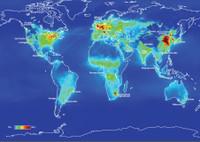 The growth of human population and the industrialisation in the 19
th
and 20
th
century has led to dramatic changes in the Earth atmosphere.
Especially the chemical composition of the atmosphere is rapidly changing as a
result of human activities. We entered the “anthropogenic” epoch, where the
activities of humans play a key role in the further development of the ozone
layer, air quality and climate change. The rapid development of megacities and
the strong development in the Asian countries are clear examples of the rapid
changes that effected the atmosphere in the last decades and will continue to
do so in the future.
The growth of human population and the industrialisation in the 19
th
and 20
th
century has led to dramatic changes in the Earth atmosphere.
Especially the chemical composition of the atmosphere is rapidly changing as a
result of human activities. We entered the “anthropogenic” epoch, where the
activities of humans play a key role in the further development of the ozone
layer, air quality and climate change. The rapid development of megacities and
the strong development in the Asian countries are clear examples of the rapid
changes that effected the atmosphere in the last decades and will continue to
do so in the future.
In the last 30 years the capability of measuring the atmospheric composition from space did grow tremendously. Due to that, the potential to operational monitor the atmosphere, following the meteorological community, is now within reach. At the same time, the importance for society of regular operational environmental measurements, related to the ozone layer, air quality and climate change, became apparent.
In this seminar I will give an overview of the leading research themes in the atmospheric domain, followed by the technical capabilities from space to measure and detect changes in the atmospheric composition. I will introduce the Ozone Monitoring Instrument (OMI) and the Tropospheric Monitoring Instrument (TROPOMI), both Dutch led satellite instruments that play an international leading role in monitoring the chemical composition of the atmosphere. Operational forecasts based on satellite data, use of these data for Protocol monitoring (Montreal, Kyoto Protocol and Air Quality Protocols) , calculations of emission inventories, and the importance of trend analyses based on long term records will be discussed. I will show several examples of our changing atmosphere based on satellite data, due to economic growth or decline, environmental regulations, regional pollution transport, infrastructure development and population migration.

